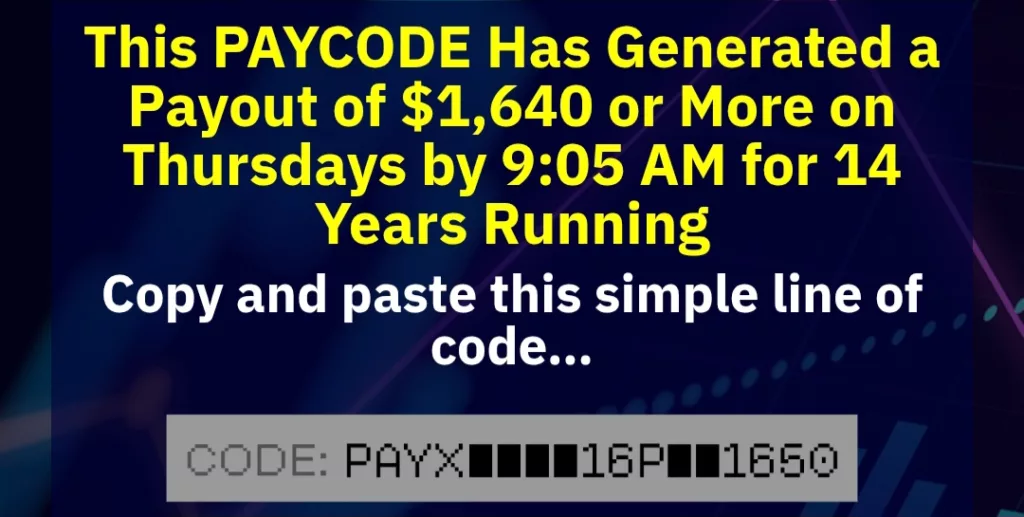Investment strategist Jim Fink is teasing an automated way to invest that will have us making money every Thursday, all year long.
He calls it “Paycodes” and he's sharing how we can become eligible to have it making money for us.
The Teaser
For some, every Thursday for the last 14 years has been payday.

Jim Fink was a lawyer by trade…until he discovered the trading secret in this teaser and used it to make a cool $5 million fortune in just a couple of years.
We have reviewed more than our share of income teasers lately, including Tim Plaehn's Freedom Number and Jim Rickard's American Birthright Pitch.
The “Paycodes” promoted in this one aren't cash advances, loans, or rebates. They’re gains, plains and simple.
Jim explains:
If we have an online trading account, can copy a simple line of numbers and letters, and paste it into your account. Then we can start collecting payouts as soon as tomorrow.
To make matters even more confusing, we have to become eligible to use Paycodes.
If I had to guess, I would say Jim is talking about a trading strategy, but the eligibility component is throwing me off.
About halfway into the teaser, Jim finally comes clean…
He admits that so-called “Paycodes” are actually options, as they are a way to trade stocks without buying or selling actual shares.
It's all made to sound and look simple.

However, these aren't just any ol' options.
This is a special kind of options trade with a built-in safety net that requires account approval.
The Pitch
All is revealed inside Jim's trading service Options for Income.

Every Thursday morning, Jim emails his latest “Paycodes“, along with step-by-step instructions on how to enter them into your investment account.
A year typically costs $1,995, but a 50% discount is being offered ($995 upfront for the first year), along with a 30-day money-back guarantee.
The Upfront Payout Options Trade
There is only one kind of options strategy that fits Jim's description.
It's called a “spread” option.
True to it's name, a spread trade is when you simultaneously buy one security and sell another security, with the spread, however wide or narrow, being the profit.
When it comes to options, opposite contracts on the same security are purchased and used as the spread.
It's why Jim used a single stock, Visa (NYSE: V), as an example in his teaser.
He noted that it didn't matter whether Visa's shares went up or down, because those following “Paycode” instructions could have made $1,500 or more either way.
Jim isn't wrong as options provide the flexibility in terms of strike price, expiry date, or both, to profit no matter what is happening in the market.
The much-hyped upfront payout component comes when you sell a put option (the option to buy a stock at a predefined price) and collect the cash premium upfront.
But Jim's not done, as he also notes an additional benefit.
The Trade Extension Strategy
A put option trade doesn’t end when you receive an upfront cash premium.
It’s closed out a few weeks later and sometimes, as in life, unexpected things happen, and a trade moves against you.
In such situations, Jim has “a safety net” that, with an additional move, enables him to extend the life of the trade, giving it the opportunity to turn into a winner.
This trade extender is the kicker that's made it possible for Jim to enjoy a 94% success rate with this strategy over the past 14 years.
No further elaboration is given, but I'm pretty sure he's talking about “rolling” the original put option by buying back the option and selling a new one with a later expiration, if it is about to expire below it's strike price.
As you can probably already tell, all of this isn't simple to pull off, which is why options, in general, require trading approval from your broker before you can start trading them in your investment account.
That's one challenge, there are a few others too, which makes us wonder if “Paycodes” losses really are as rare as a snowstorm in the Mojave Desert.
Make Money on 9 out of 10 Trades?
There are a few things to unpack here.
The first, and most obvious, is that not everyone who potentially wants to try out the “Paycodes” strategy will receive broker approval to do so.
Approval is based on stated income and financial experience, so not everyone will meet their broker's arbitrary thresholds.
Second, although Jim mentions that he “makes money on the same big-name stocks again and again“, like Procter & Gamble, Lab Corp., and Amazon. These change every week, so we're completely dependent on his Options for Income service to receive these recommendations every Thursday.
Lastly, and perhaps most importantly, what Jim doesn't tell us is that put option buyers have limited risk (the price they paid for the option), sellers (that's us), however, face potentially unlimited losses, if the underlying stock that options are sold on goes up.
There's really no way to mitigate this, except with probability, which is Jim's hope.
Apparently, he uses a highly refined “seasonality” formula to maximize the accuracy of his options trades.
For example, if a stock has gone up 9 times out of 10 during a similar time of year, under similar circumstances, then it’s probably going to do the same thing again.
That’s why he hunts for stocks that have a “90% likelihood of going up in a specific seasonal time frame.”
Nevertheless, when it comes to trading options, the numbers remain the same – around 75-80% of options traders lose money.
Proceed only with capital you can afford to lose or not at all.
Quick Recap & Conclusion
- Investment strategist Jim Fink is teasing an automated way to invest called “Paycodes” that he promises will have us making money every Thursday, all year long.
- Later in the teaser, Jim admits that so-called “Paycodes” are actually put options, but there's also a built-in safety net and account approval component to his strategy.
- All is revealed inside Jim's trading service Options for Income. A year typically costs $1,995, but a 50% discount is currently being offered ($995 upfront for the first year), with a 30-day money-back guarantee.
- No specific tickers are teased, but you will need your broker's approval to start trading options in yourinvestment account.
- Put options, rolling options, high-probability setups, at the end of the day, 75-80% of options traders still lose money.
Have you tried Jim Fink's “Paycodes” options strategy? Tell us about your experience in the comments.

